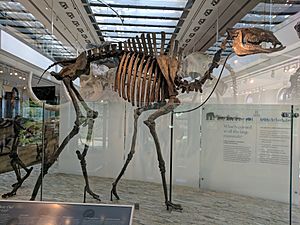Titanotylopus facts for kids
Quick facts for kids Titanotylopus |
|
|---|---|
 |
|
| T. nebraskensis skeleton | |
| Scientific classification |
|
| Kingdom: | Animalia |
| Phylum: | Chordata |
| Class: | Mammalia |
| Order: | Artiodactyla |
| Family: | Camelidae |
| Tribe: | Camelini |
| Genus: | Titanotylopus Barbour & Schultz, 1934 |
| Species | |
|
†Titanotylopus nebraskensis |
|
| Synonyms | |
|
|
Titanotylopus was a type of giant camel that is now extinct. This means it no longer lives on Earth. It was a genus (a group of closely related species) of land-living herbivores. Herbivores are animals that eat only plants. Titanotylopus belonged to the Camelidae family, which includes modern camels and llamas.
This amazing animal lived in North America. It roamed the land from about 10.3 million years ago until about 300,000 years ago. That's a very long time! It existed for about 10 million years in total.
Contents
What Does the Name Titanotylopus Mean?
The name Titanotylopus comes from ancient Greek words.
- "Τιτάν" (Titan) means "giant".
- "τύλος" (tylos) means "knob" or "hump".
- "πούς" (pous) means "foot".
So, the name Titanotylopus means "giant knobby-foot." This name likely refers to its large size and possibly the shape of its feet or the presence of humps, like modern camels.
Where Did This Giant Camel Live?
Titanotylopus was endemic to North America. This means it lived only in North America and nowhere else in the world. It lived during two important time periods:
- The Miocene epoch (about 23 to 5.3 million years ago).
- The Pleistocene epoch (about 2.6 million to 11,700 years ago).
During these times, North America had different climates and landscapes than today. Titanotylopus would have lived alongside other ancient animals.
How Big Was Titanotylopus?
As its name suggests, Titanotylopus was a very large animal. It was one of the biggest camels that ever lived. Scientists believe it could have been as tall as 11 feet (3.4 meters) at the shoulder. This would make it much taller and heavier than today's camels. Its large size helped it to reach high branches for food and to protect itself from predators.
What Did Titanotylopus Eat?
Since Titanotylopus was a herbivore, it ate plants. Its large size and long neck would have allowed it to browse on leaves and branches from tall trees and shrubs. It likely ate a variety of plants found in the ancient North American grasslands and woodlands.
Why Did Titanotylopus Become Extinct?
Many large animals, including Titanotylopus, became extinct around the end of the Pleistocene epoch. Scientists are still studying the exact reasons. Some possible causes include:
- Climate change: The Earth's climate changed a lot during the end of the Ice Age. This could have affected the plants Titanotylopus ate.
- Loss of habitat: As climates changed, the environments where these camels lived might have shrunk or disappeared.
- Competition: Other animals might have competed with Titanotylopus for food and resources.
- Human activity:' Early humans were present in North America during the later part of Titanotylopuss existence. Hunting by humans might have played a role in the extinction of some large animals.
See also
 In Spanish: Titanotylopus para niños
In Spanish: Titanotylopus para niños

